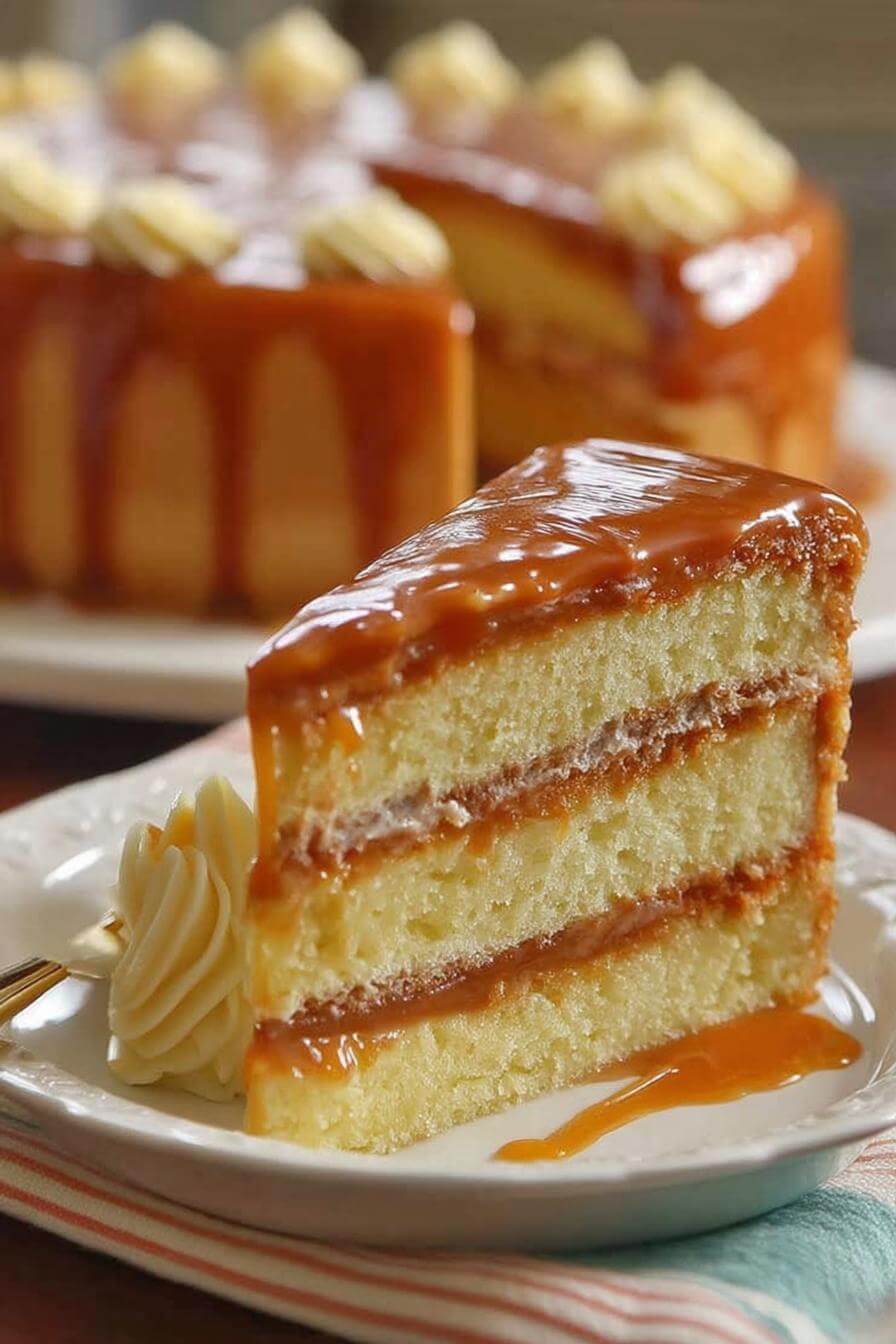If you’ve ever found yourself craving a slice of cake so cozy it feels like a warm embrace, you’re in the right place. Let’s talk about a dessert that makes your kitchen smell like a little sugar-coated sanctuary.
Why You’ll Love It
This isn’t just another cake—it’s a mini adventure in your own kitchen. Watching sugar and butter transform over gentle heat into a deep amber caramel is like witnessing everyday magic. You stir, you wait, and suddenly that glossy sauce clings to your spoon like liquid gold.
Here’s the thing: you don’t need perfect layers or museum-worthy frosting lines. A few drips or uneven swirls only add to its charm. Friends will ooh and aah at the flavor, not the precision. And the aroma? It’s downright hypnotic. One whiff, and your living room feels like a cozy café on a rainy afternoon.
Timing and Servings
Plan for about three to three and a half hours from start to finish—but most of that is hands-off time. While your oven and stovetop do their thing, you can catch up on a favorite podcast, read a few chapters of a book, or simply revel in that buttery-vanilla scent wafting through your home. The cake yields 10–12 generous slices—perfect for family gatherings, book clubs, or treating yourself over several mornings. If you’re hosting a party, slicing into 14–16 pieces makes them just the right nibble size.
Ingredients
- For the cake:
2 sticks (1 cup) unsalted butter, room temperature
⅓ cup vegetable oil
2½ cups granulated sugar
6 large eggs, room temperature
2 tablespoons pure vanilla extract
3 cups cake flour, sifted
2 tablespoons baking powder
½ teaspoon fine salt
1 cup sour cream - For the icing:
1½ sticks unsalted butter
2 (12-ounce) cans evaporated milk
2 cups granulated sugar
2 teaspoons vanilla extract
Directions
- Preheat and prep pans. Heat oven to 350°F. Grease three 9-inch round cake pans, dust with flour or use baking spray with flour.
- Cream butter, oil, and sugar. In a mixer, beat 1 cup butter, vegetable oil, and 2½ cups sugar on medium speed until pale and fluffy (about 5 minutes).
- Add eggs and vanilla. Drop in eggs one at a time, beating well after each addition. Scrape the bowl, then stir in 2 tablespoons vanilla.
- Sift dry ingredients. Whisk together cake flour, baking powder, and salt. Sifting ensures a light, tender crumb.
- Combine batter. With mixer on low, add one-third of the flour blend, then half the sour cream. Repeat, finishing with flour. Mix just until combined—you don’t want to overwork the gluten.
- Bake. Divide batter evenly among pans. Bake 25–30 minutes, rotating halfway if needed. A toothpick should come out with a few moist crumbs, not raw batter.
- Cool cakes. Let pans rest on wire racks for 10 minutes. Then invert cakes, remove pans, and cool completely.
- Make caramel icing. In a heavy-bottomed pot, melt 1½ sticks butter over medium heat. Stir in evaporated milk and 2 cups sugar until dissolved. Lower to medium–low and stir often for about 90 minutes, until the mixture reaches a deep amber and coats a spoon thickly.
- Finish icing. Remove from heat, stir in 2 teaspoons vanilla, and let sit 15–20 minutes. If it firms too much, gently rewarm; if still loose, cook a bit longer.
- Assemble. Place one cake layer on a plate. Spoon on icing, letting drips decorate the edge. Repeat with remaining layers and frost the sides—celebrate the rustic look.
Variations
- Salted Caramel Twist: Sprinkle flaky sea salt between layers or atop the finished cake for a sweet-salty pop.
- Pecan Enchantment: Stir ½ cup chopped pecans into the icing during the last 10 minutes of cooking.
- Chocolate Affair: Melt 4 ounces dark chocolate, drizzle over the cooled cake, and watch guests swoon.
- Citrus Breeze: Add 1 teaspoon orange or lemon zest to the batter for a bright, tangy lift.
- Coffee Kick: Dissolve 1 tablespoon instant espresso in the evaporated milk before cooking for a gentle mocha note.
Storage & Reheating Tips
This cake actually mellows overnight. Store at room temperature in an airtight container for up to 48 hours—watch the icing seep into the crumb for extra moisture. If it’s warm where you live, refrigerate and then let it sit 30 minutes before slicing. To freeze, wrap slices tightly in plastic wrap, then foil. Freeze flat for up to a month. Thaw overnight in the fridge, then warm slices in a 275°F oven for 10 minutes to recapture that fresh-baked vibe.
FAQs
Can I swap the sour cream?
Yes—full-fat plain Greek yogurt is a terrific stand-in. It adds a slight tang without messing with texture.
Save This Recipe
Why isn’t my icing thickening?
Patience is key. Keep the heat low, stir often, and resist the urge to rush it. If you see grainy bits, lower the temperature even more.
Can I use sweetened condensed milk?
You can, but cut the sugar by about ½ cup. Condensed milk brings extra sweetness and richness, so you don’t want to go overboard.
How do I know when the cake is done?
Look for golden edges and a toothpick that emerges with a few damp crumbs. If it’s shiny batter, give it another minute or two.
Are uneven layers a problem?
Absolutely not. Embrace the homemade look—once everyone tastes that caramel hug, they’ll rave about the flavor, not the symmetry.
Conclusion
Making this caramel cake is like giving yourself permission to linger a little longer in the kitchen, to let simple ingredients shine. That slow-cooked icing fills your home with nutty, buttery warmth, and each spoonful is pure comfort. Share slices with friends, savor them in quiet moments, or—no judgment here—keep a sliver all to yourself. After all, you’ve earned every decadent bite.

Homemade Caramel Cake
Ingredients
- 1 cup unsalted butter room temp (2 sticks)
- ⅓ cup vegetable oil
- 2½ cups sugar
- 6 eggs room temp
- 2 tbsp vanilla extract
- 3 cups cake flour sifted
- 2 tbsp baking powder
- ½ tsp salt
- 1 cup sour cream
- 1½ sticks unsalted butter for icing
- 2 cans evaporated milk 12 oz each
- 2 cups sugar for icing
- 2 tsp vanilla extract for icing
Instructions
- Preheat oven to 350°F. Grease and flour three 9-inch round cake pans.
- In a stand mixer, beat butter, oil, and sugar until pale and fluffy (about 5 minutes).
- Add eggs one at a time, then stir in vanilla.
- In a separate bowl, sift flour, baking powder, and salt.
- Add flour to the butter mixture in three additions, alternating with sour cream. Begin and end with flour. Mix until just combined.
- Divide batter evenly between pans. Bake 25–30 minutes, or until a toothpick comes out with crumbs. Cool in pans 10 minutes, then remove to cool completely.
- For the icing, melt butter in a heavy-bottomed pot. Stir in evaporated milk and sugar. Cook over medium-low heat, stirring often, for about 90 minutes.
- Icing is ready when thickened, amber-colored, and coats a spoon. Remove from heat, stir in vanilla, and cool slightly (15–20 minutes).
- To assemble, place one cake layer on a plate. Spread icing on top, then repeat with remaining layers. Finish by spreading icing around the sides.
- Let the cake sit to set the icing. Slice and serve.
